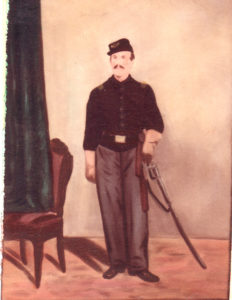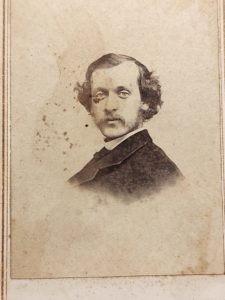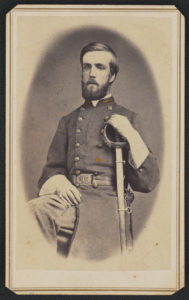2nd Lt. Simon Pincus, 66th New York Infantry (c. 1864)
17 October 2023
Simon Pincus was a Sergeant in Company C, 66th New York Infantry when he was wounded in action at Antietam on 17 September 1862. He was commissioned 2nd Lieutenant in March 1864 and mustered out of service in August 1865.
This portrait, probably based on or painted over a photograph, was kindly provided by its owner, his great-great-grandson Ross Schacher.
George E Curtis, 4th Rhode Island Infantry
30 September 2023
On the afternoon of 17 September 1862 the 4th Rhode Island Infantry were in action at Antietam in a large cornfield on the Otto farm above the lower (later Burnside’s) bridge:
… as the enemy showed the national flag (the corn concealing their uniform), and as our troops had been seen in advance on our right, moving diagonally across our front, the order to cease firing was given, and a volunteer officer to go forward to ascertain who was in our front was called for. Lieutenant George E. Curtis and George H. Watts immediately stepped forward, and placing themselves one on each side of the color bearer (Corporal Tanner, Company G), carried the flag up the hill within 20 feet of the rebels, when the enemy fired, killing the corporal. Lieutenant Curtis seized the colors and returned, followed by Lieutenant Watts.
This fine photograph was sent me by Robert Grandchamp from his personal collection. The quote above is from Lieutenant Colonel Curtis’ after-action Report.
Lt Smith Spangler Turner, 17th Virginia Infantry
15 September 2023
A photograph in the Liljenquist Family Collection of Civil War Photographs at the Library of Congress. A former VMI cadet and later US Congressman, Lieutenant Turner was noted for his actions on South Mountain on 14 September and at least slightly wounded at Sharpsburg on 17 September 1862.



